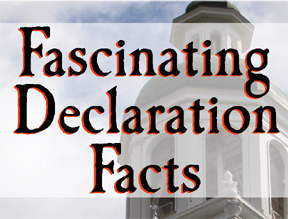|

1)The Original- But
Not The First
After voting to adopt the
Declaration written by Thomas Jefferson, Congress engaged John
Dunlap to print broadside copies of the document. That night
Dunlap produced somewhere over 200 copies. Later
that week the Congressional Calligrapher, Timothy Matlack, was
asked to create the engrossed (hand penned) version. The
engrossed Declaration would be signed by the 52 members of the
Continental Congress as the “original Declaration” but the
Dunlap broadside came first.
2)John Hancock’s
Giant Signature
The story that has long
been told claims that John Hancock placed his overly large
signature on the Declaration and said, “There, now King George
can read it without his spectacles.” The story, while
charming, is not true. King George never saw the signed
document. He was sent a printed version which bore only
Hancock’s name as President of the Continental Congress. Many
samples of John Hancock’s signature have survived and all of
them are large. Apparently John had a very strong self image
and his signature reflected it.
3)The Declaration
Was Not Signed On July 4 1776
On July 2nd
1776 the Congress voted for Independence. On July 4th,
they voted to adopt the actual Declaration. The engrossed
version of the document was not signed until August 1776. The
names of the signers were not to appear in a publicly printed
form until December 1777.
4)Slavery In The
Declaration
Thomas Jefferson’s
original hand written version of the declaration contained a
scathing denouncement of slavery. When the Declaration was
brought before congress, many amendments were made before it
could pass. Sadly, some Southern states would not vote for the
Declaration until the denouncements were removed. What did
survive are the words “.that all men are created equal, that
they are endowed by their Creator with certain unalienable
Rights, that among these are Life, Liberty and the pursuit of
Happiness.” It would take a later war to make these words a
reality and end slavery in America.
5)A Missing Colony
Only 12 of the original 13
colonies voted to adopt the Declaration of Independence. New
York abstained from voting because of no clear direction to
vote for it from the home state. With no votes cast against
it, the document was officially adopted.
6)A Message On The
Back Of The Declaration
There is, in fact, a
message on the back of the Declaration of Independence. It
reads, “Original Declaration of Independence, dated July 4
1776.” This appears at the bottom of the document and upside
down. It was written there so that it could be easily
identified when rolled up. There is no treasure on the back.
The treasure is on the front.
7)A Nest Of Rebels
Just by being a member of
the Second Continental Congress you were considered a traitor
by King George III. Many prominent leaders in Congress had a
price put on their heads. When they signed a declaration and
pledged their life, their fortune and their sacred honor, they
really were truly risking all of it.
8)The End For Two
Signers
Two of the original
signers of the Declaration died on the same date. Thomas
Jefferson and John Adams had been good friends, bitter rivals,
and finally reconciled to friends again. Both men died on the
4th of July 1826. Adams last words were, “Jefferson
still lives”. He did not know that his friend, fellow signer
and fellow former President had died a few hours earlier.
9)The Army Discovers
Independence
A printed copy of
Declaration was sent to General Washington in New York where
the continental army held the city. On July 9th 1776,
Washington had the troops assembled and ordered that the
declaration be read to them. Later that night, the soldiers
filled with independent spirit knocked down a statue of King
George III which stood at the foot of Broadway on the Bowling
Green. The statue was mainly cast of lead and would be melted
down for bullets. A fragment of Washington’s copy of the
Declaration still exists at the Library of Congress.
|